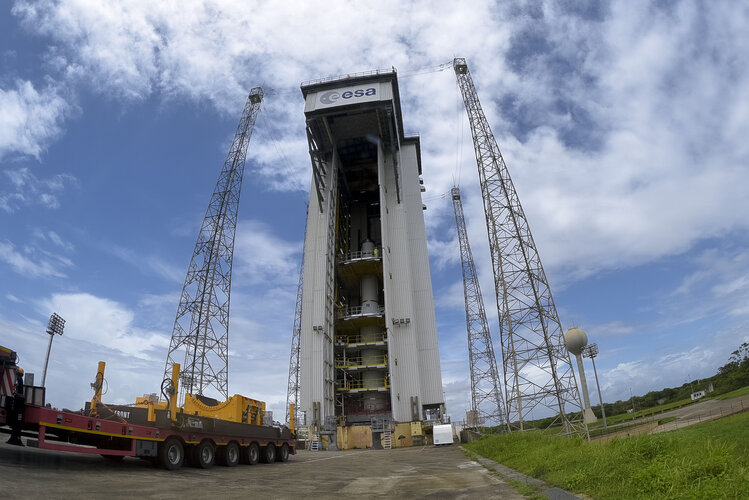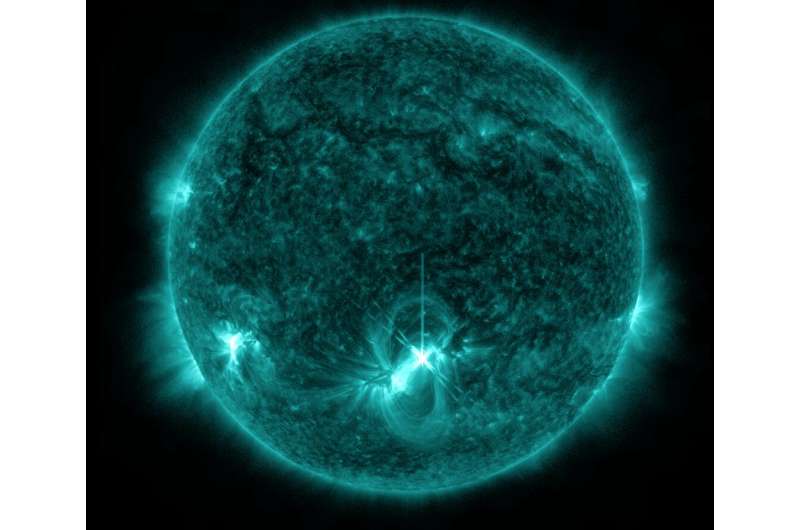
Copernical Team
Vega-C stacks up for inaugural flight VV21

Preparation for VV21, the inaugural flight of ESA’s new Vega-C rocket, continues at pace with integration of the Zefiro-9 solid-fuel third stage.
News Conference with ESA Astronaut Matthias Maurer (in German)
 Video:
00:54:47
Video:
00:54:47
After almost six months of living and working on board the International Space Station, Matthias Maurer is back on Earth - and gives his first news conference in Europe.
Watch the replay of this live Q&A (mostly in German language) between Matthias and the press, taking place at the ESA’s European Astronaut Centre (EAC) in Cologne, Germany.
Identifying global poverty from space
 Despite successes in reducing poverty globally in the last two decades, almost one billion people are still living without access to reliable and affordable electricity, which in turn negatively affects health and welfare, and impedes sustainable development. Knowing where these people are is crucial if aid and infrastructure are to reach them. A new IIASA-led study proposes a novel method to es
Despite successes in reducing poverty globally in the last two decades, almost one billion people are still living without access to reliable and affordable electricity, which in turn negatively affects health and welfare, and impedes sustainable development. Knowing where these people are is crucial if aid and infrastructure are to reach them. A new IIASA-led study proposes a novel method to es Satellite eyes pinpoint waste from space to reduce ocean pollution
 A cutting-edge new tool developed by Minderoo Foundation has identified thousands of waste sites across 25 countries for the first time using advanced satellite data technology and machine learning to measure piles of plastic waste from space.
Global Plastic Watch (globalplasticwatch.org) is a tool which combines earth observation with artificial intelligence to create the first-ever near-
A cutting-edge new tool developed by Minderoo Foundation has identified thousands of waste sites across 25 countries for the first time using advanced satellite data technology and machine learning to measure piles of plastic waste from space.
Global Plastic Watch (globalplasticwatch.org) is a tool which combines earth observation with artificial intelligence to create the first-ever near- Unpacking black-box models
 Modern machine-learning models, such as neural networks, are often referred to as "black boxes" because they are so complex that even the researchers who design them can't fully understand how they make predictions.
To provide some insights, researchers use explanation methods that seek to describe individual model decisions. For example, they may highlight words in a movie review that inf
Modern machine-learning models, such as neural networks, are often referred to as "black boxes" because they are so complex that even the researchers who design them can't fully understand how they make predictions.
To provide some insights, researchers use explanation methods that seek to describe individual model decisions. For example, they may highlight words in a movie review that inf Keeping time with the cosmos
 Various technologies, networks and institutions benefit from or require accurate time keeping to synchronize their activities. Current ways of synchronizing time have some drawbacks that a new proposed method seeks to address. The cosmic time synchronizer works by synchronizing devices around cosmic ray events detected by those devices. This could bring accurate timing abilities to remote sensin
Various technologies, networks and institutions benefit from or require accurate time keeping to synchronize their activities. Current ways of synchronizing time have some drawbacks that a new proposed method seeks to address. The cosmic time synchronizer works by synchronizing devices around cosmic ray events detected by those devices. This could bring accurate timing abilities to remote sensin Warp speed 'Unruh effect' can finally be tested in the lab
 A major hurdle for work at the forefront of fundamental physics is the inability to test cutting-edge theories in a laboratory setting. But a recent discovery opens the door for scientists to see ideas in action that were previously only understood in theory or represented in science fiction.
One such theory is on the Unruh effect. When astronauts in a spacecraft undergo super strong accel
A major hurdle for work at the forefront of fundamental physics is the inability to test cutting-edge theories in a laboratory setting. But a recent discovery opens the door for scientists to see ideas in action that were previously only understood in theory or represented in science fiction.
One such theory is on the Unruh effect. When astronauts in a spacecraft undergo super strong accel Orbex reveals first full-scale microlauncher rocket developed in Europe
 Orbex has unveiled the first full-scale prototype of the Prime orbital space rocket on its dedicated launch pad publicly for the first time.
The unveiling of the first of a new generation of European launch vehicles - designed to launch a new category of very small satellites to orbit - represents a major step forward for the British rocket company as it prepares for the first ever vertica
Orbex has unveiled the first full-scale prototype of the Prime orbital space rocket on its dedicated launch pad publicly for the first time.
The unveiling of the first of a new generation of European launch vehicles - designed to launch a new category of very small satellites to orbit - represents a major step forward for the British rocket company as it prepares for the first ever vertica Strong solar flare erupts from sun

The Sun emitted a strong solar flare on Tuesday, May 10, 2022, peaking at 9:55 a.m. EDT. NASA's Solar Dynamics Observatory, which watches the sun constantly, captured an image of the event.
Space For Humanity to send its first Citizen Astronaut on next New Shepard flight
 Today, Space For Humanity (S4H), a 501(c)(3) nonprofit organization, announced its selection committee has chosen Katya Echazarreta to become the organization's first ever citizen astronaut ambassador. Katya will become the first Mexican-born female to fly to space when she flies aboard Blue Origin's NS-21 flight.
Katya, an electrical and computer engineer and online science educator, was
Today, Space For Humanity (S4H), a 501(c)(3) nonprofit organization, announced its selection committee has chosen Katya Echazarreta to become the organization's first ever citizen astronaut ambassador. Katya will become the first Mexican-born female to fly to space when she flies aboard Blue Origin's NS-21 flight.
Katya, an electrical and computer engineer and online science educator, was 
































